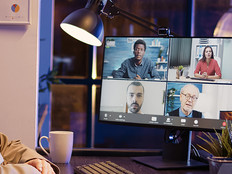One World, One You
 Unified communication (UC) is the intersection of historically separate information technology realms. Think in terms of how the typical office worker handles passwords and receives messages: Most people have a PC logon ID at work, a desk phone and, for many IT managers, a cell phone. Messages are received via e-mail, voice mail and instant messaging. UC’s goal is to manage all those points of entry and deliver a single identity and point of presence for each individual.
Unified communication (UC) is the intersection of historically separate information technology realms. Think in terms of how the typical office worker handles passwords and receives messages: Most people have a PC logon ID at work, a desk phone and, for many IT managers, a cell phone. Messages are received via e-mail, voice mail and instant messaging. UC’s goal is to manage all those points of entry and deliver a single identity and point of presence for each individual.
Technology vendors that traditionally have handled one aspect of a company’s communications are targeting this new area. Voice vendors such as Avaya and Nortel are offering software on servers. Cisco, traditionally a source for routers and switches, now makes call-handling devices and software, and recently bought WebEx to claim desktop dollars. And desktop heavyweight Microsoft is starting to offer physical phones through third parties such as Polycom.
Microsoft is not new to hardware; Redmond has delved into keyboards and mice before, and the Xbox is a great success. For UC, they’ve partnered with Polycom to produce two distinct lines of Voice over Internet Protocol (VoIP) phones: the Tanjay and the Catalina. The Tanjay line offers a full-featured IP phone with a touch screen, while the Catalina phones have a considerably smaller footprint and leave off the touch screen. For this review, I’ll focus on the Polycom CX700 IP Phone, part of the Tanjay line.
End-User Experience
The Polycom CX700 IP Phone boasts a large 5.7-inch 18-bit-per-pixel color touch screen with 320 x 240 resolution. The default text size and buttons are large enough even for someone with big fingers, like me. An on-screen touch keyboard appears when the user needs it — for instance, while logging on to the phone. Because the unit is integrated with Microsoft Windows Active Directory, workers can use the same logon name and password they use to log on to their PC.
The phone is embedded with Microsoft’s Office Communicator 2007 (OC 2007) client, with room for roughly six to seven contacts on the screen at a time. Each contact shows the availability of the user on the other end, a feature known as “enhanced presence.” Users can know if the contact is available, busy, on a call or in a meeting.
To place a call, the user simply selects a contact by scrolling through a list using an iPod-style circular touch wheel below the screen. Depending on the recipient’s settings, a phone will ring — it could be their desk phone, cell phone, or some other device they’ve had their calls forwarded to. One really nice feature is that the Polycom CX700 includes high-definition audio. In my tests, the people I called had no idea I was on an IP phone; they figured I was using an analog handset.
The Polycom CX700 IP Phone also lets users take calls in the way that’s best for them. There’s a comfortable handset for those who prefer traditional phone use. Users can also plug in a wireless headset, which I like to do to stretch my legs and walk around the office while I’m on a call. It also includes a full-duplex speakerphone. Full-duplex means that even while talking, the user can still hear people talking on the other end, which is much more like natural conversation and is a feature usually available only in conference-room speakerphones.
Why It Works for IT
The first thing I noticed was how easy it was to get the phone up and running. It can use IEEE 802.3af Class 2 Power over Ethernet, but it also comes with a standard power adapter.
![]()
What best describes your business plans for integrating voice and data systems?
40% We have no plans to integrate voice and data systems.
37% We're already doing it.
17% We're looking into doing it in the next 12 months.
6% We're looking into doing it in the next six months.
Simply plug it into the network, and when it boots it lets the user immediately log on to Microsoft Office Communications Server 2007 (OCS 2007), just like a Microsoft OCS 2007 client. I entered my sign-in name, logon ID and password, then all my contacts appeared on the screen and the phone was ready to rock.
The VoIP features of OCS 2007 are included in the Polycom CX700, so the user does not need a computer to take advantage of these features. Simply by logging on to the phone, the user has full access to the telephone numbers and status of her contacts, no matter where she plugs it into the corporate network. It even works from home by deploying an OCS edge server or connecting through the USB to a computer with a VPN connection.
The CX700 comes with two Ethernet jacks — one to the network, the other to chain up to the user’s desktop computer; a USB input port to connect the phone to a computer instead of over Ethernet; and a USB standard port for an external headset or other device. There’s no need for an Ethernet or USB hub in each user’s office; the CX700 just sits in line with any of the user’s existing connections.
Because it is an OCS 2007 client, the phone integrates thoroughly with Microsoft Exchange 2003/2007, Outlook 2003/2007 and OCS 2007.
Users can also have an OCS 2007 client on their desktop and be logged on simultaneously on the desktop client and on the phone. It was quite amazing how quickly one device showed a status change when I changed my status on the other. If the user also has a softphone on their computer and a call comes in, both the softphone and CX700 will ring, allowing the user to answer either.
For those worried about security, there is a policy set in OCS 2007 that can require a 6-digit PIN or fingerprint scan after the phone is idle for a preset number of minutes. After all, the phone is now essentially a computer and could contain sensitive information.
Disadvantages
Because this is Microsoft’s first foray into VoIP phones, even with a reputable partner like Polycom, the CX700 has its limitations. There’s no getting around that the phone requires a solid Microsoft OCS 2007 infrastructure. Making an outside call on a Public Switched Telephone Network (PSTN) requires connecting OCS 2007 through its mediation server component to another vendor’s media gateway. Here, the devil’s in the details, as this means connecting two usually disparate systems, a Microsoft server and a PBX.
I also found that the right-hand scroll bar on the touch screen was positioned much too close to the right-hand border of the screen, making it virtually useless for someone with large fingers. However, the circular iPod-style touch wheel more than makes up for this shortcoming.
The fingerprint swipe reader had difficulty reading my fingerprint. I often needed to swipe my index finger two or three times to unlock the phone. I consistently have this issue with just about any fingerprint reader I use, so I’m not sure if it’s my finger or if these devices aren’t quite as robust as they need to be.
Finally, the Polycom CX700 IP Phone comes with a fairly high price tag. For a number of small-business owners, it might be more practical to go with a Catalina, the Polycom CX200 or the wireless model, the Polycom CX400. After all, if the company deploying OCS 2007 and the users all have access to computers, they can just use the OCS 2007 client already deployed on their desktop to make calls and determine presence information.[BT]
CDW Price: $538.98
Get your company into the world of unified communication with a high-quality IP phone that features:
Dr. Jeffrey Sheen is the lead enterprise analyst for Grange Mutual Casualty Company of Columbus, Ohio.






